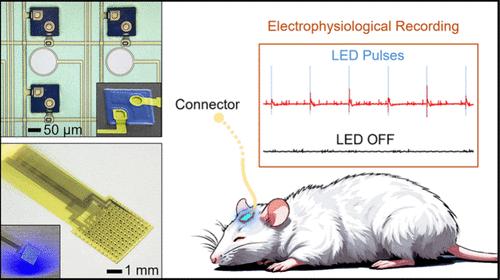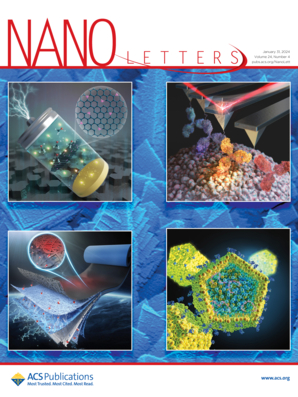Large-Scale, High-Density MicroLED Array-Based Optogenetic Device for Neural Stimulation and Recording
IF 9.6
1区 材料科学
Q1 CHEMISTRY, MULTIDISCIPLINARY
引用次数: 0
Abstract
Optogenetics has emerged as a pivotal tool in neuroscience, enabling precise control of neural activity through light stimulation. However, the current microLED arrays lack sufficient density and scalability. This study proposes an innovative optogenetic device capable of integrating hundreds of microLEDs and electrocorticography (ECOG) electrodes. Individual or multiple microLEDs in the device can be selectively controlled with a custom controller. The light intensity of microLEDs decreases with increasing brain tissue penetration while maintaining a low temperature rise during pulse stimulations. In addition, interference from microLED pulses on ECOG electrode recordings could be alleviated with local mean subtraction data processing. The optogenetic device enables high-quality neural signal recording and triggers a significant enhancement in neural activity following light stimulation. Integration of microLED arrays and ECOG electrodes in the optogenetic device represents a promising advancement in neuroscientific research, providing improved spatial and temporal recording and control over neural activity.

用于神经刺激和记录的大规模、高密度微型 LED 阵列光遗传装置
光遗传学已成为神经科学领域的重要工具,可通过光刺激精确控制神经活动。然而,目前的微型 LED 阵列缺乏足够的密度和可扩展性。本研究提出了一种创新的光遗传学装置,能够集成数百个微型 LED 和皮质电图(ECOG)电极。该装置中的单个或多个微型 LED 可通过定制控制器进行选择性控制。微型 LED 的光强度会随着脑组织穿透力的增加而降低,同时在脉冲刺激过程中保持较低的温升。此外,微型 LED 脉冲对 ECOG 电极记录的干扰可通过局部均值减法数据处理来减轻。该光遗传装置能够记录高质量的神经信号,并在光刺激后显著增强神经活动。在光遗传装置中集成微型 LED 阵列和 ECOG 电极是神经科学研究的一大进步,可改善对神经活动的时空记录和控制。
本文章由计算机程序翻译,如有差异,请以英文原文为准。
求助全文
约1分钟内获得全文
求助全文
来源期刊

Nano Letters
工程技术-材料科学:综合
CiteScore
16.80
自引率
2.80%
发文量
1182
审稿时长
1.4 months
期刊介绍:
Nano Letters serves as a dynamic platform for promptly disseminating original results in fundamental, applied, and emerging research across all facets of nanoscience and nanotechnology. A pivotal criterion for inclusion within Nano Letters is the convergence of at least two different areas or disciplines, ensuring a rich interdisciplinary scope. The journal is dedicated to fostering exploration in diverse areas, including:
- Experimental and theoretical findings on physical, chemical, and biological phenomena at the nanoscale
- Synthesis, characterization, and processing of organic, inorganic, polymer, and hybrid nanomaterials through physical, chemical, and biological methodologies
- Modeling and simulation of synthetic, assembly, and interaction processes
- Realization of integrated nanostructures and nano-engineered devices exhibiting advanced performance
- Applications of nanoscale materials in living and environmental systems
Nano Letters is committed to advancing and showcasing groundbreaking research that intersects various domains, fostering innovation and collaboration in the ever-evolving field of nanoscience and nanotechnology.
 求助内容:
求助内容: 应助结果提醒方式:
应助结果提醒方式:


